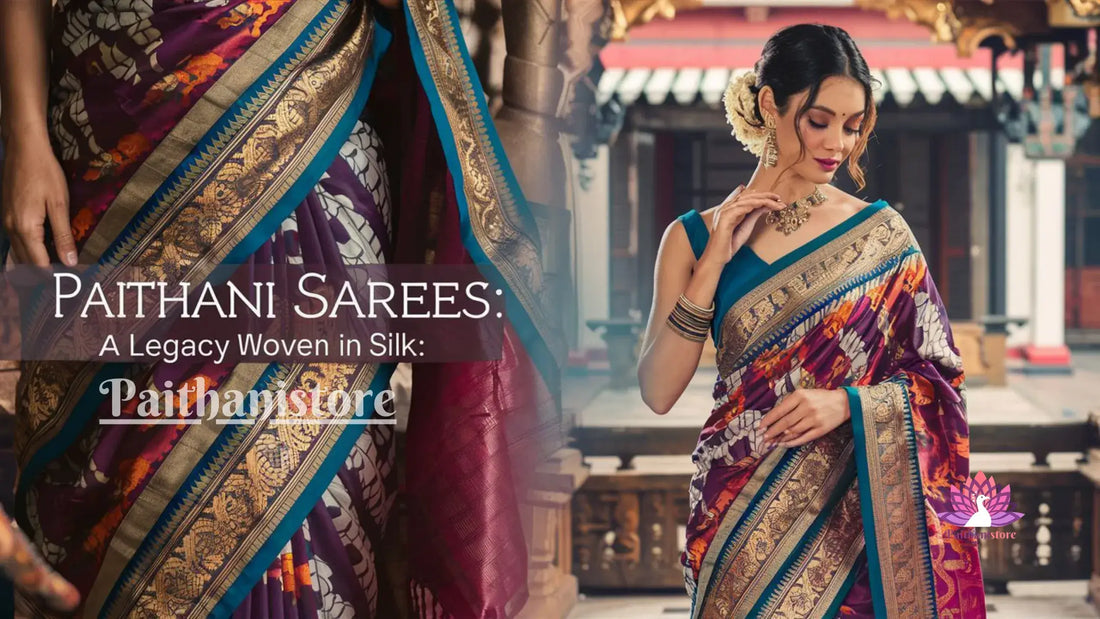The Paithani saree, a masterpiece of Indian handloom weaving, embodies timeless elegance and rich cultural heritage. Draped in royalty, celebrated for its intricate designs, and coveted for its luxurious feel, the Paithani saree continues to captivate hearts across generations. But where does this captivating garment originate, and what makes it so special?
Where are Paithani Sarees Made?
The story of the Paithani saree begins in Yeola, a town nestled in the western Indian state of Maharashtra. This region, renowned for its rich textile heritage, has been crafting these exquisite sarees for centuries. The name "Paithani" itself is believed to have originated from the village of Paithan, another center for silk weaving in Maharashtra and currently paithani sarees are made in Yeola with the name Yeola Paithani Sarees.
Where is Paithani Saree Famous?
Paithani sarees have transcended geographical boundaries and captured the hearts of saree lovers across India. However, they hold a special significance in Maharashtra, particularly in the Maratha community. Traditionally worn by brides on their wedding day, Paithani sarees are considered a symbol of cultural pride and heirloom pieces passed down through generations.
Which Paithani is Best?
While beauty is subjective, the quality of a Paithani saree is determined by several factors. Here's what to consider:
- Material: Genuine Paithani sarees are crafted from the finest silk, known for its softness, strength, and luxurious drape.
- Weaving Technique: The hallmark of a Paithani saree is the intricate zari work directly woven into the silk, creating a seamless and visually stunning effect. Look for sarees with a high zari count for added richness.
- Design Motifs: Traditional Paithani sarees feature geometric and floral motifs like "Ashta Patti" (eight-petal lotus), "Aansu" (tear drop), Peacock, Parrot, and "Kalash" (pot). These motifs hold cultural significance and tell captivating stories.
- The "Ekdali" Pallu: A telltale sign of an authentic Paithani saree is the unique "Ekdali" design on the "Pallu" (end piece), featuring a single central "Mayur" (peacock) motif.
Why is Paithani So Expensive?
The high cost of Paithani sarees reflects the meticulous craftsmanship and dedication involved in their creation. Each saree is a testament to the skill of generations of weavers who preserve this age-old tradition. Here's what contributes to the price:
- Handloom Weaving: Unlike mass-produced sarees, Paithanis are passionately woven by hand on traditional looms. This slow and intricate process ensures quality and exclusivity.
- Pure Silk: The use of high-quality silk adds to the luxurious feel and durability of the saree.
- Zari Work: The intricate zari work, often featuring real gold or silver threads, adds to the opulence and value of the saree.
- Time and Skill: The intricate weaving process can take weeks or even months to complete, depending on the complexity of the design. The skill and experience of the weaver also play a significant role in the final product.
Experience the timeless elegance of a Paithani saree! Explore our curated collection of authentic Paithani sarees at Paithanistore. We offer a wide variety of colors, designs, and styles to suit your taste and celebrate your special occasions. Visit our website or store today and discover the magic of Paithani for yourself! Paithanistore
Difference Between Paithani and Semi-Paithani
While both Paithani and Semi-Paithani sarees boast intricate designs and a rich aesthetic, there are key differences to consider when making your choice:
- Material: Genuine Paithani sarees are crafted from pure silk, known for its softness, breathability, and characteristic rustle. Semi-Paithani sarees may use a blend of silk and other yarns, such as cotton or synthetic fibers, impacting the drape and feel.
- Weaving Technique: The defining feature of a Paithani saree is the "Handloom" weaving technique, where the zari work is directly woven into the silk, creating a seamless and reversible effect. Semi-Paithani sarees often employ the "Powerloom" technique, where zari threads are separately attached to the base fabric, resulting in a less intricate and non-reversible design.
- Zari Work: Authentic Paithani sarees traditionally use real gold or silver threads for the zari work, adding to their weight, value, and luster. Semi-Paithani sarees may use metallic threads made of less precious metals or synthetic materials, affecting their visual appeal and longevity.
- Cost: Due to the factors mentioned above, Paithani sarees are generally more expensive than Semi-Paithani sarees.
Choosing the Right Paithani for You
Whether you're a seasoned saree shopper or a newcomer captivated by the beauty of Paithani sarees, understanding your needs and preferences is crucial. Here are some pointers to guide you:
- Occasion: Are you seeking a statement piece for a wedding or a sophisticated drape for a festive occasion? Paithani sarees cater to a variety of events, with more intricate designs and zari work often reserved for grander celebrations.
- Budget: Consider your budget when making a choice. Paithani sarees are an investment, and their price reflects the artistry and materials involved. Semi-Paithani sarees might be a suitable option if you're on a budget or looking for a lighter everyday wear saree.
- Personal Style: Paithani sarees come in a vibrant spectrum of colors and designs. Choose a saree that complements your taste and flatters your body type. Don't be afraid to experiment with different design elements and color combinations to find your perfect Paithani match.
Caring for Your Paithani Saree
Paithani sarees are delicate creations, and proper care is essential to preserve their beauty for generations to come. Here are some tips:
- Dry Cleaning: Opt for dry cleaning your Paithani saree by a professional to ensure gentle cleaning and proper care.
- Hand Washing (Optional & Not Recommended ): If handwashing at home, use a mild detergent specifically formulated for delicate fabrics. Avoid wringing or twisting the saree, and dry it flat in a shaded area. Iron on the lowest heat setting if necessary.
- Storage: Store your Paithani saree in a cool, dry place away from direct sunlight. Use lightweight cloth or acid-free tissue paper to prevent creases and fading.
Beyond the Fabric: The Cultural Significance of Paithani Sarees
The Paithani saree is more than just a garment; it's a thread woven into the rich tapestry of Indian culture. For centuries, these sarees have been an integral part of Maharashtrian traditions, adorning brides, gracing festivals, and symbolizing social status. Wearing a Paithani saree isn't just a fashion statement; it's a connection to heritage, a celebration of craftsmanship, and an embodiment of timeless elegance.
The Paithani saree, a masterpiece of artistry and cultural legacy, continues to enthrall the world with its captivating beauty. By understanding its origin, appreciating its intricate details, and learning the art of its care, you can become a proud custodian of this timeless tradition. Explore the exquisite collection of Paithani sarees at Paithanistore, and discover a saree that speaks to your heart and reflects your unique style.
Drape yourself in timeless elegance! Visit https://paithanistore.com/collections/all to discover the magic of Paithani sarees and explore our curated collection.
Contact Us:
- Phone: +91-9545931007
- Email: paithanistoreyeola@gmail.com
Official at Paithanistore.com

